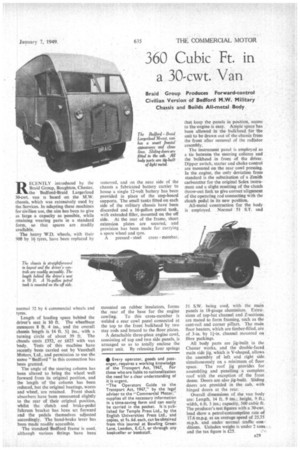360 Cubic Ft. in a 30-cwt. Van
Page 55

If you've noticed an error in this article please click here to report it so we can fix it.
Braid Group Produces Forward-control Civilian Version of Bedford M.W. Military Chassis and Builds All-metal Body
RECENTLY introduced by the Braid Group, Boughton, Chester. the Bedford-Braid Largerioad 30-cwt. van is based on the M.W. chassis, which was extensively used by the Services. In adapting these machines for civilian use, the aim has been to give as large a capacity as possible. while retaining wearing parts in a standard form, so that spares are readily available.
The heavy W.D. wheels, with their 900 by 16 tyres. have been replaced by normal 32 by 6 commercial wheels and tyres.
Length of loading space behind the driver's seat is 10 ft. The wheelbase measures 8 ft. 4 ins., and the overall chassis length is 14 ft. 5/ ins., with a turning circle of about 39 ft. The chassis costs £312.. or £625 with van body. Tests of this machine have recently been carried out by Vauxhall Motors, Ltd., and permission to use the name " Bedford " in this connection has been granted.
The angle of the steering column has been altered to bring the wheel well forward from its original position. and the length of the column has been reduced, but the original bearings, worm and wheel, are retained. Front shock absorbers have been remounted slightly to the rear of their original position, whilst the clutch and brake-pedal fulcrum bracket has been set forward and the pedals themselves adjusted accordingly. The hand-brake lever has been made readily accessible. • The standard Bedford frame is used. although various fittings have been removed, and on the near side of the chassis a fabricated battery carrier to house a single 12-volt battery has been provided in place of the step-board supports. The small tanks fitted on each side of the military chassis have been discarded and a 16-gallon petrol tank, with extended filler, mounted on the off side. At the rear of the frame, short extension plates are secured, and provision has been made for carrying a spare wheel and tyre.
A pressed steel cross member, mounted on rubber insulators, forms the rear of the base for the engine cowling. To this cross-member is welded a rear cowl panel connected at the top to the front bulkhead by two stay rods and braced to the floor plates.
A detachable three-piece engine cowl. consisting of top and two side panels, is arranged so as to totally enclose the power unit. By releasing four springs
that keep the panels in position, access to the engine is easy. Ample space has been allowed in the bulkhead fOr the unit to be drawn out of the chassis from the front after removal of the radiator assembly.
The instrument panel is employed as a tie between the steering column and the bulkhead in front of the driver. Dipper switch, starter and choke control arc mounted on the rear cowl pressing. In the engine, the only deviation from standard is the substitution of a Zenith carburetter for the original Soles instrument and a slight resetting of the clutch throw-out fork to give correct alignment of the operating rod connecting with the clutch pedal in its new position.
All-metal construction for the body is employed. Normal 51 S.T. and
51 S.W. being used, with the main panels in 18-gauge aluminium. Extrusions of top-hat channel and Z-sections are mated to form framing, such as the cant-rail and corner pillars. The main floor bearers, which are timber-filled. are of 3-in. by 11-in. channel mounted on fibre packings.
All body parts are jig-built in the Chester works, and the double-faced main side jig, which is V-shaped, allows the assembly of left and right side simultaneously on a minimum of floor space. The roof jig provides for assembling and panelling a complete roof with the exception of the front dome. Doors are also jig-built. Sliding doors are provided in the cab, with hinged doors at the rear.
Overall dimensions of the van body are: Length. 14 ft. 9 ins.: height. 9 ft.; width, 6 ft. 3 ins.; capacity, 360 cubic ft. The producer's test figures with a 30-cwt. load show a petrol-consumption rate of 17.6 m.p.g. at an average speed of 25.75 m.p.h. and under normal traffic conditions. Unladen weight is under 2 tons. and the tax figure is £25.




















































































